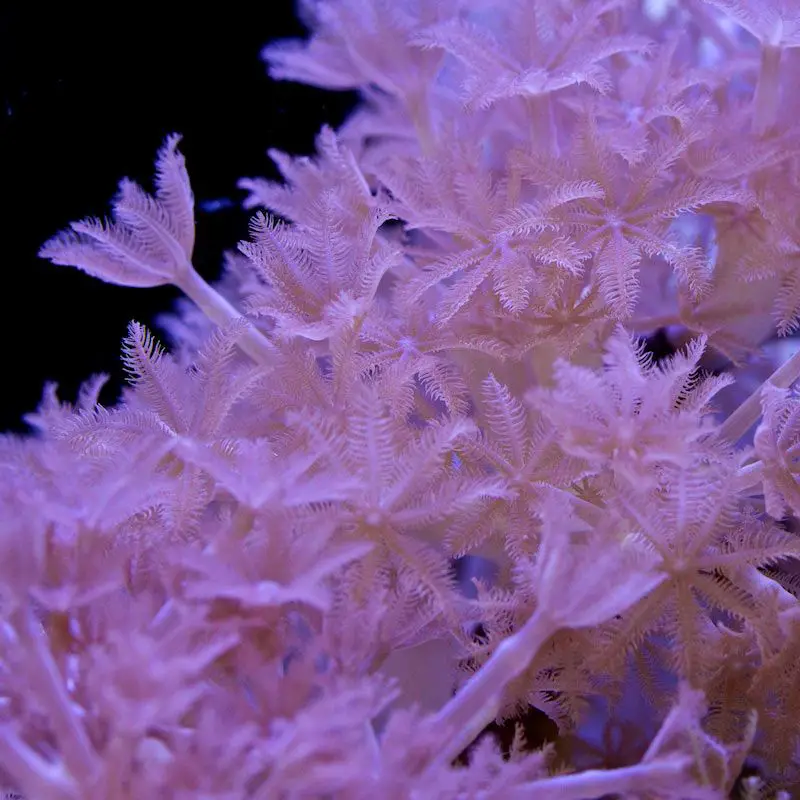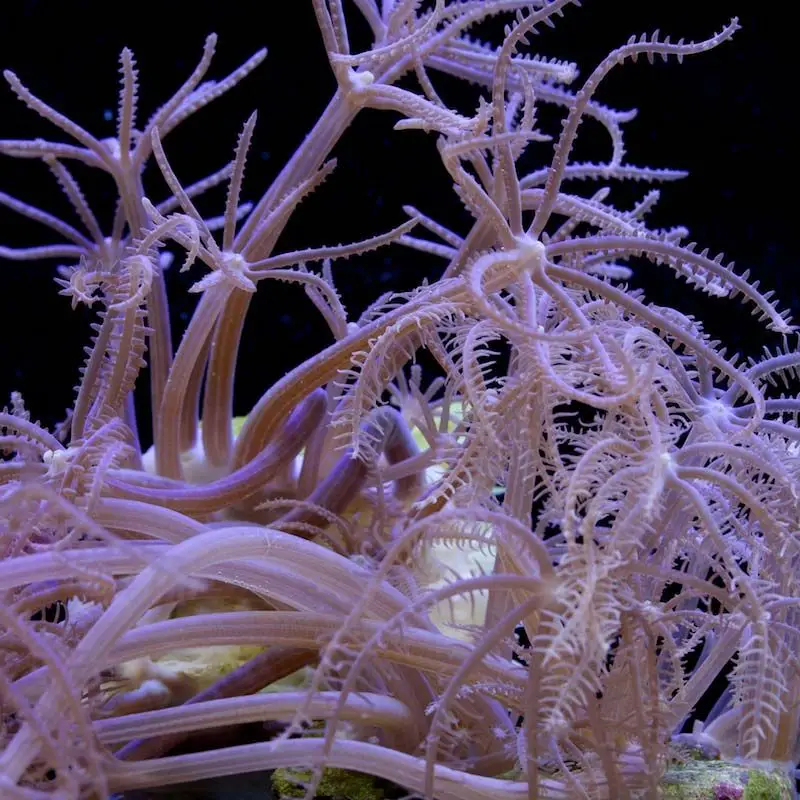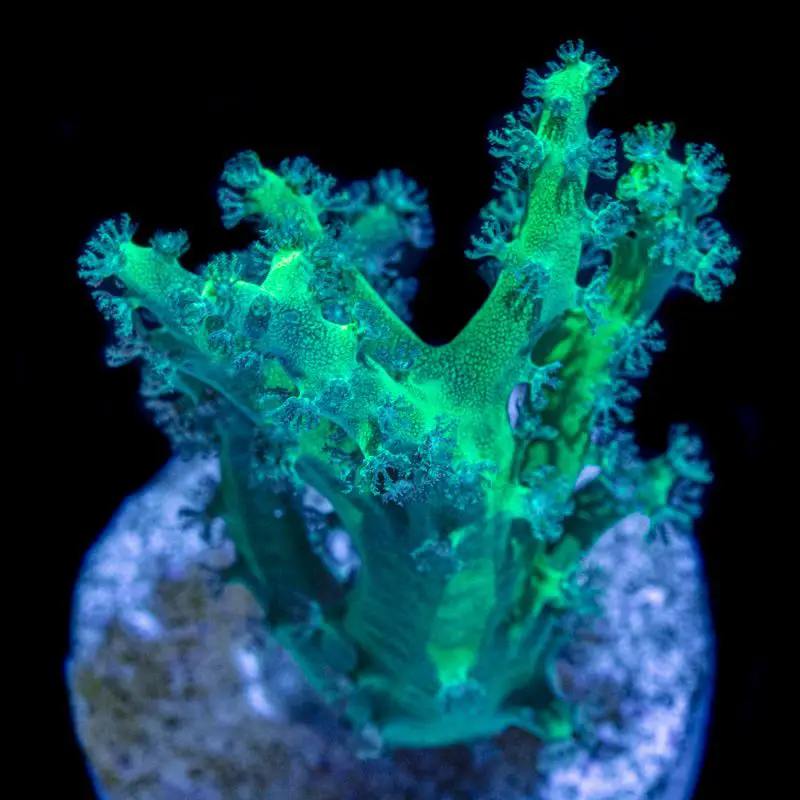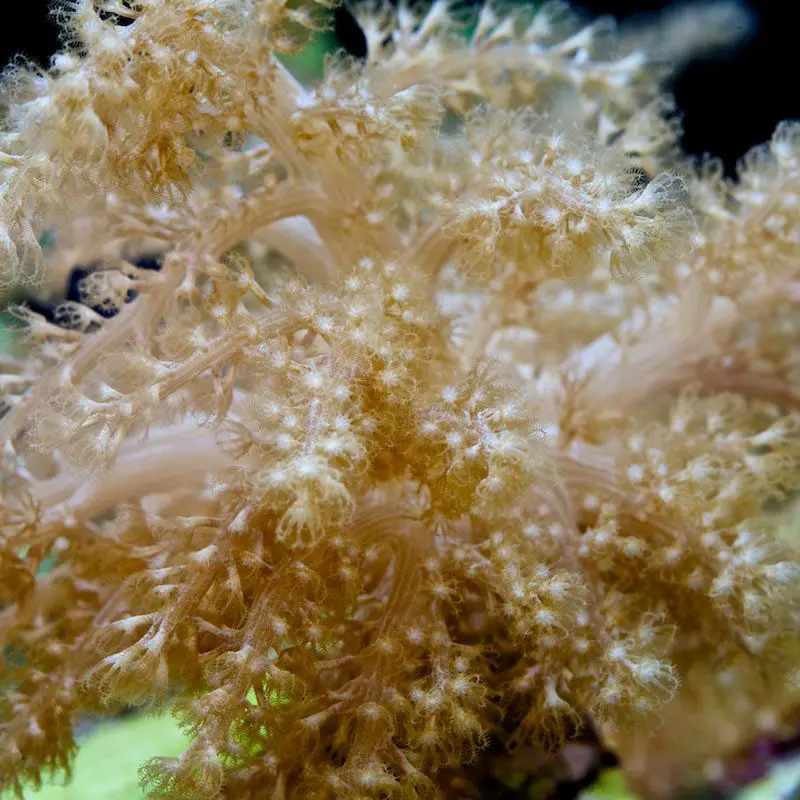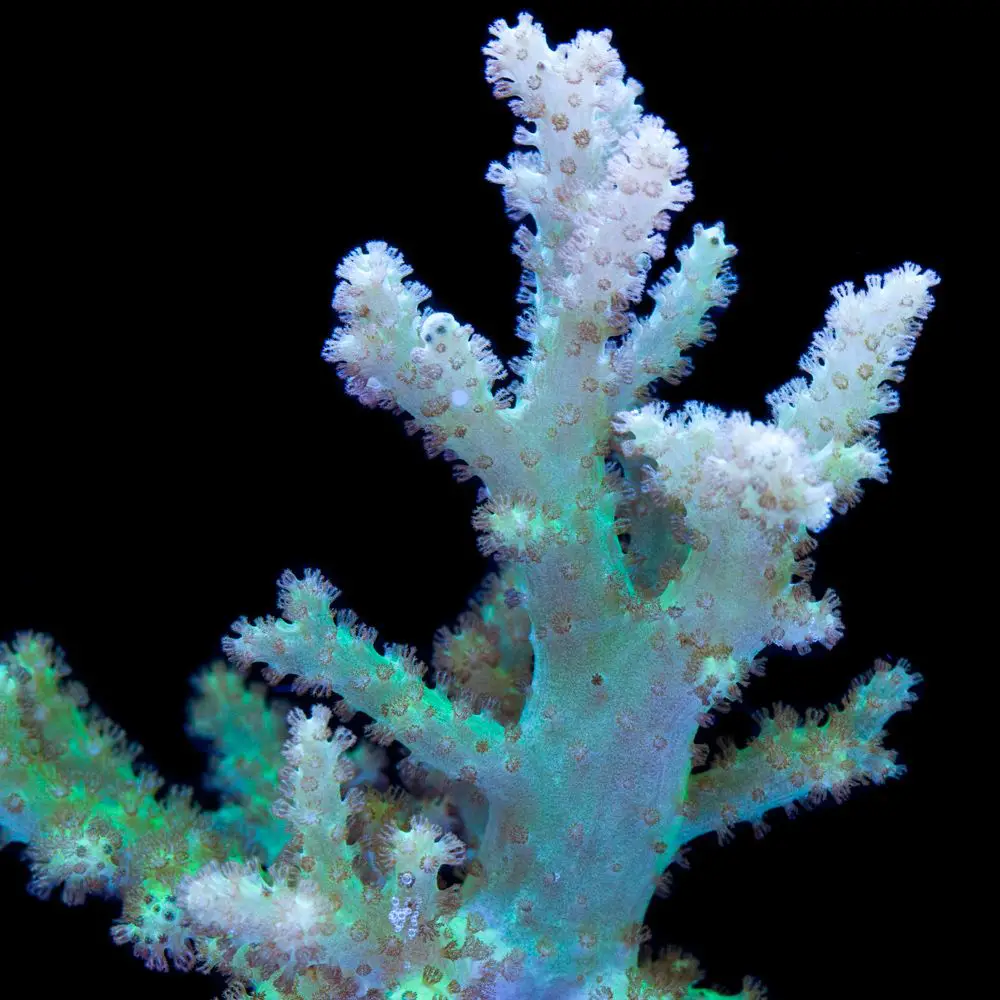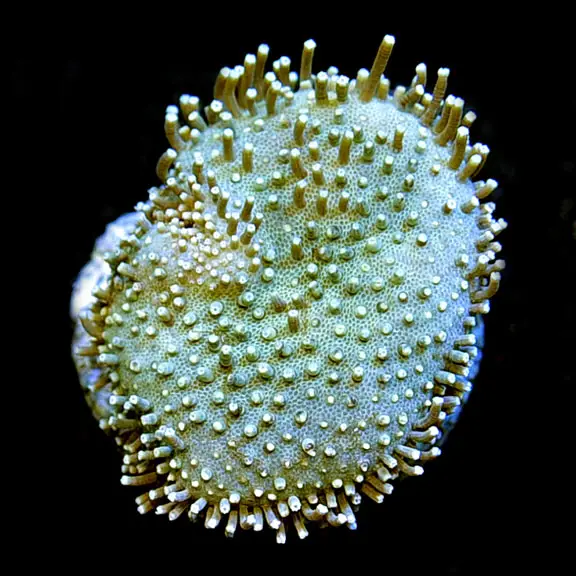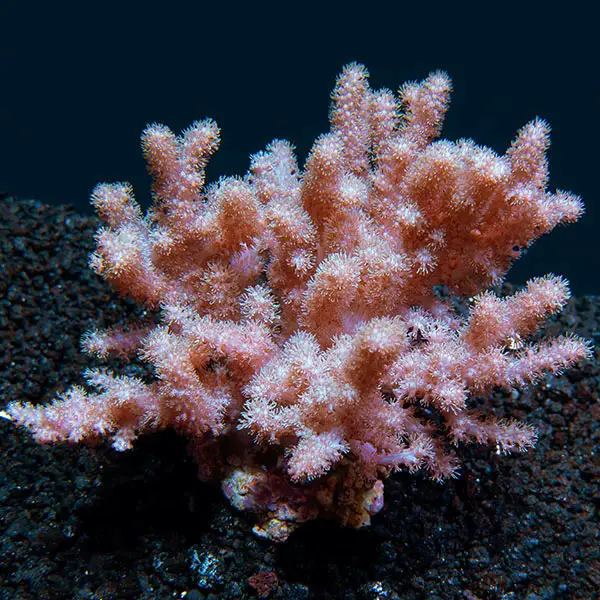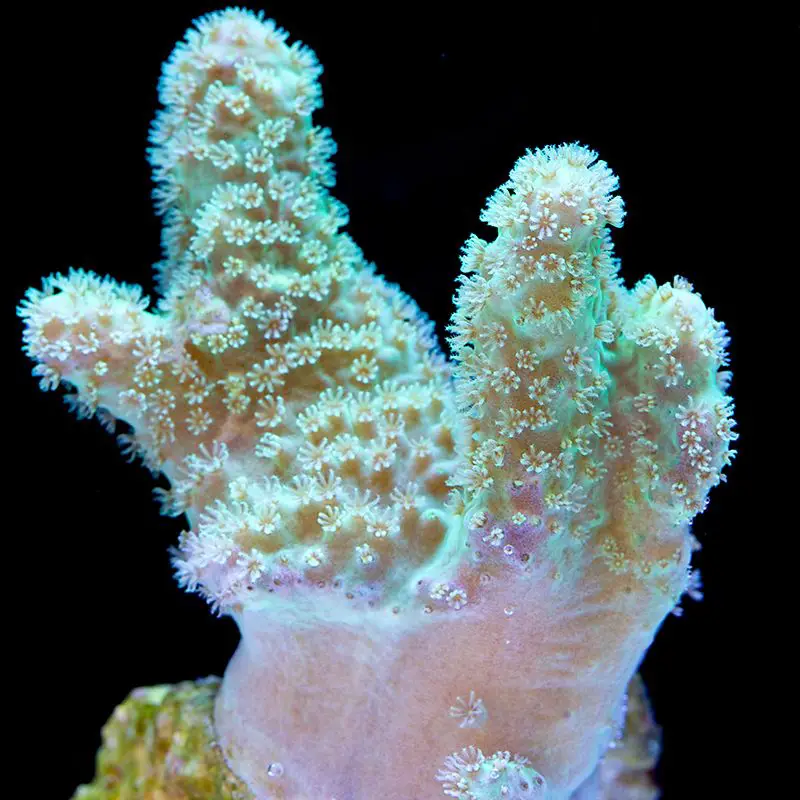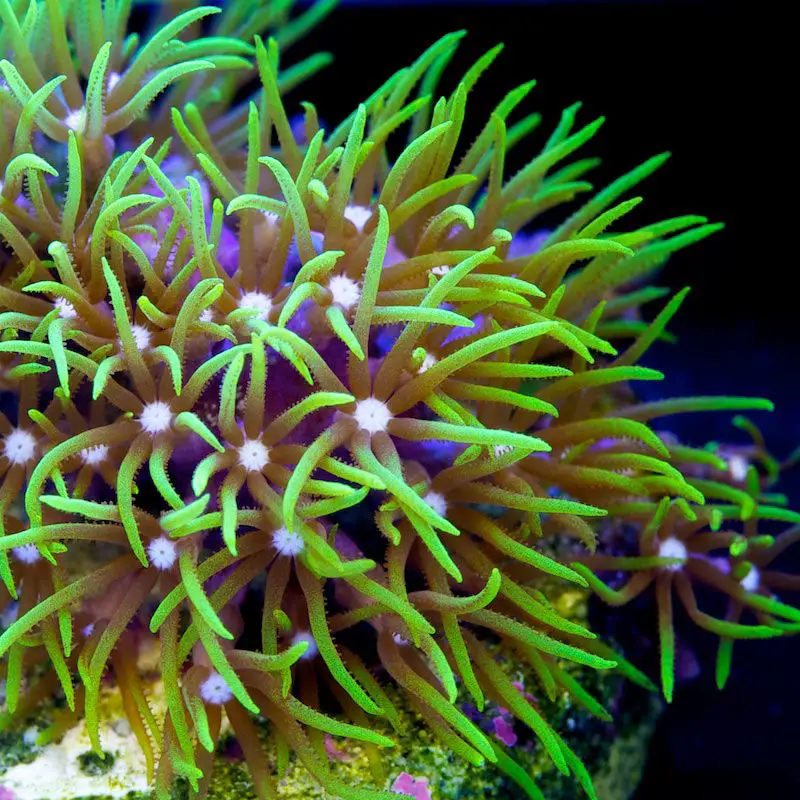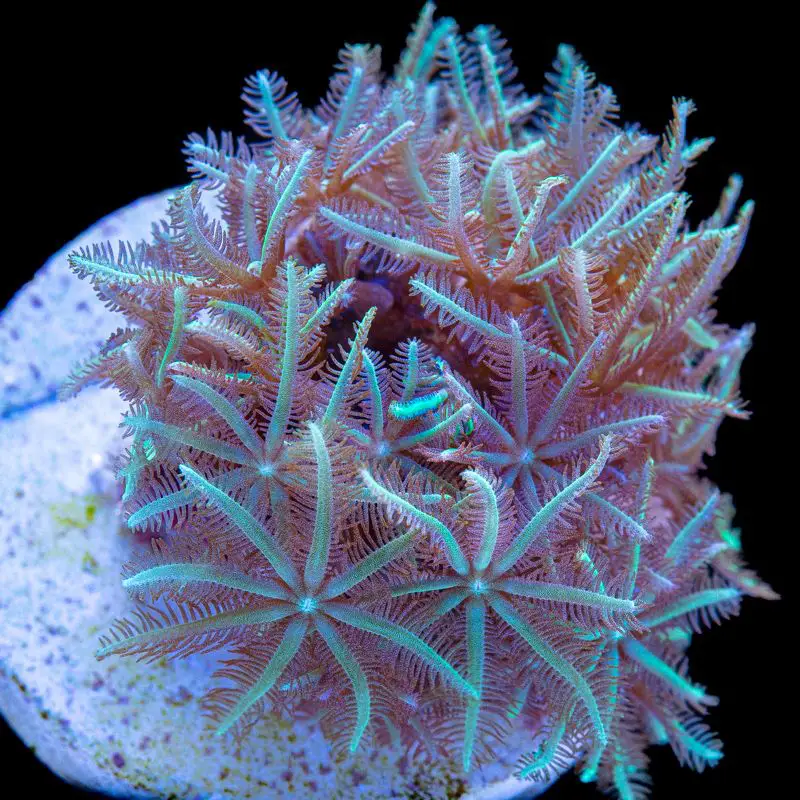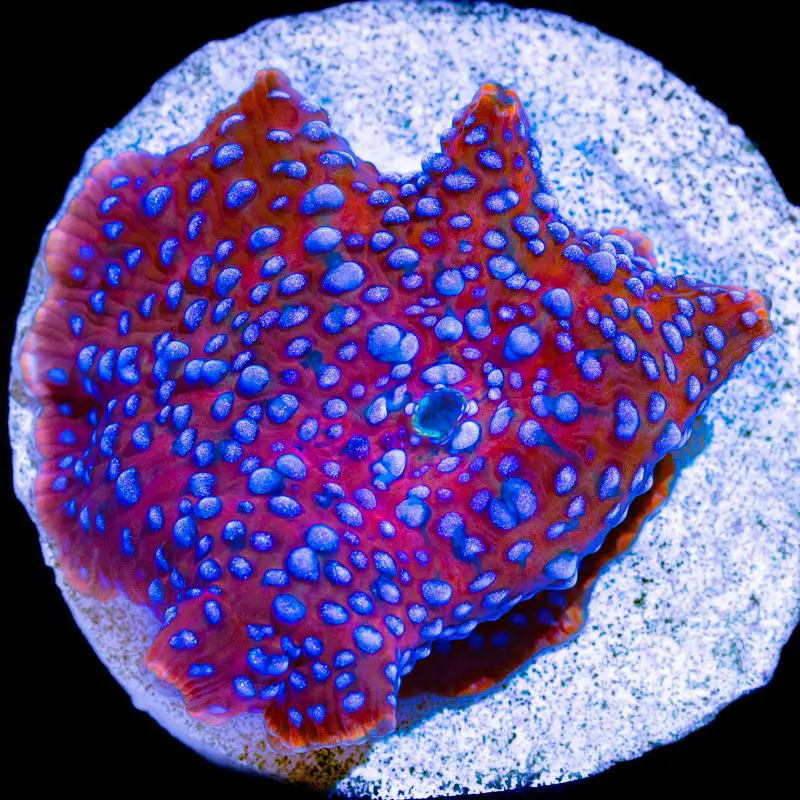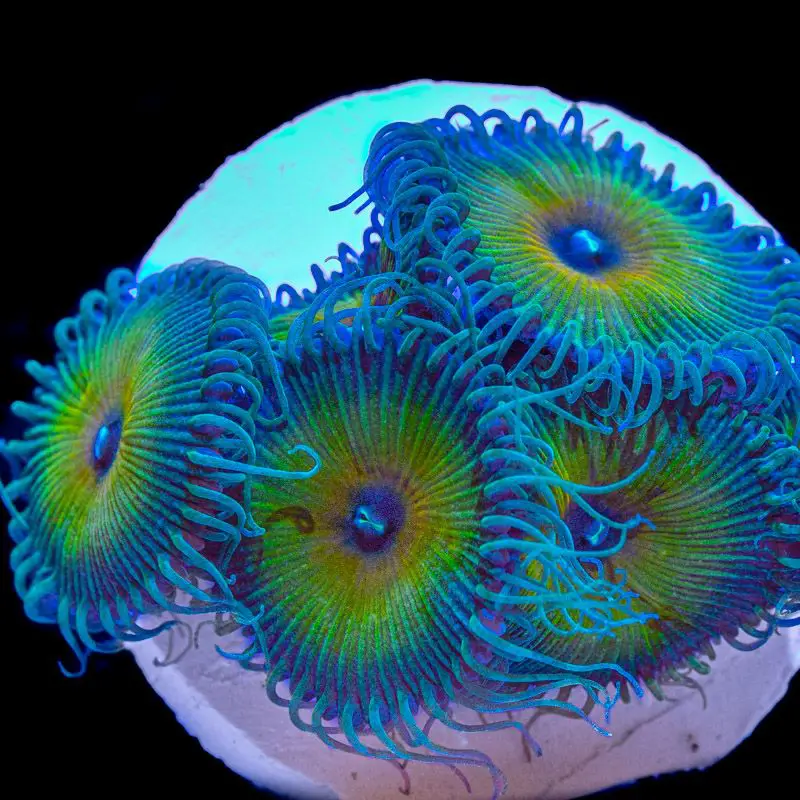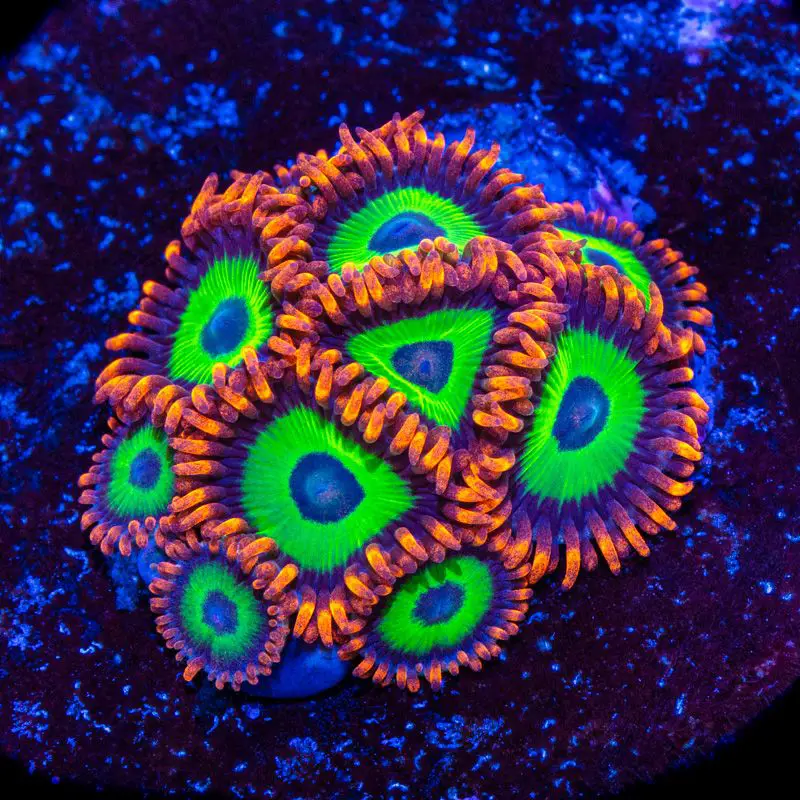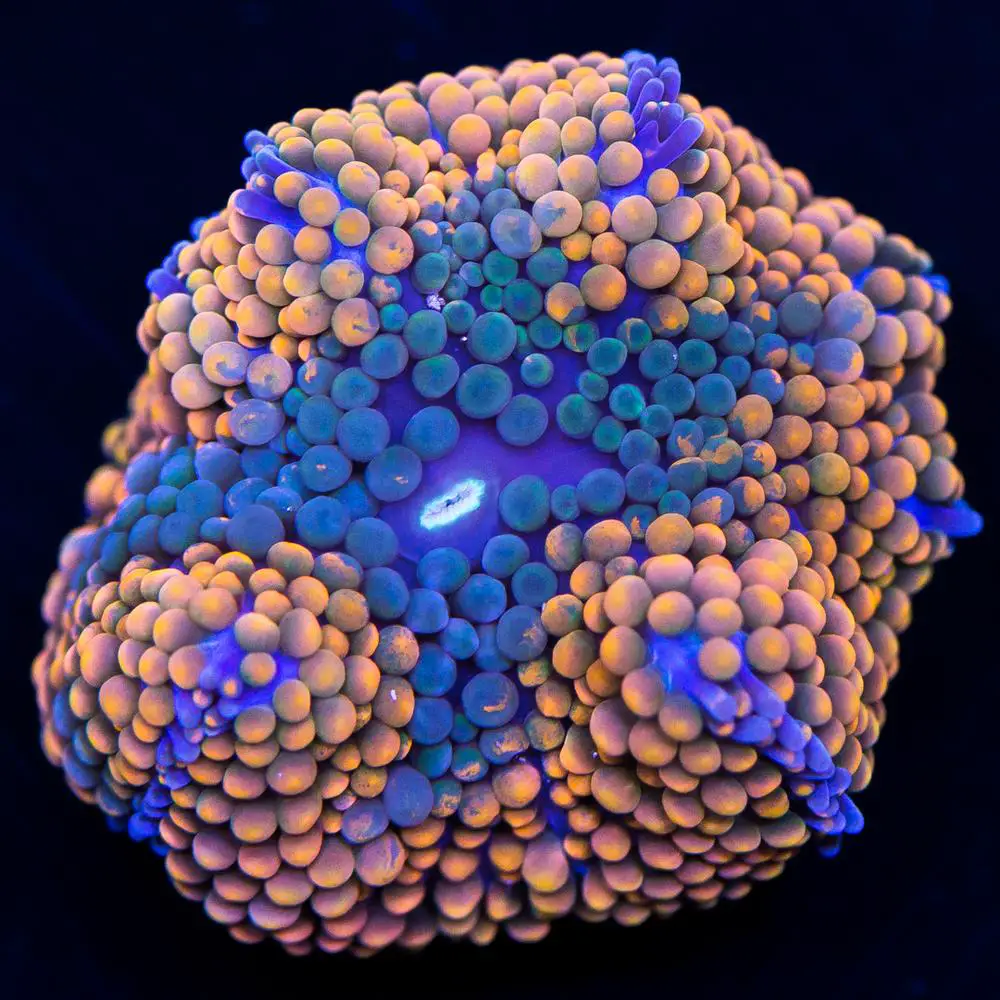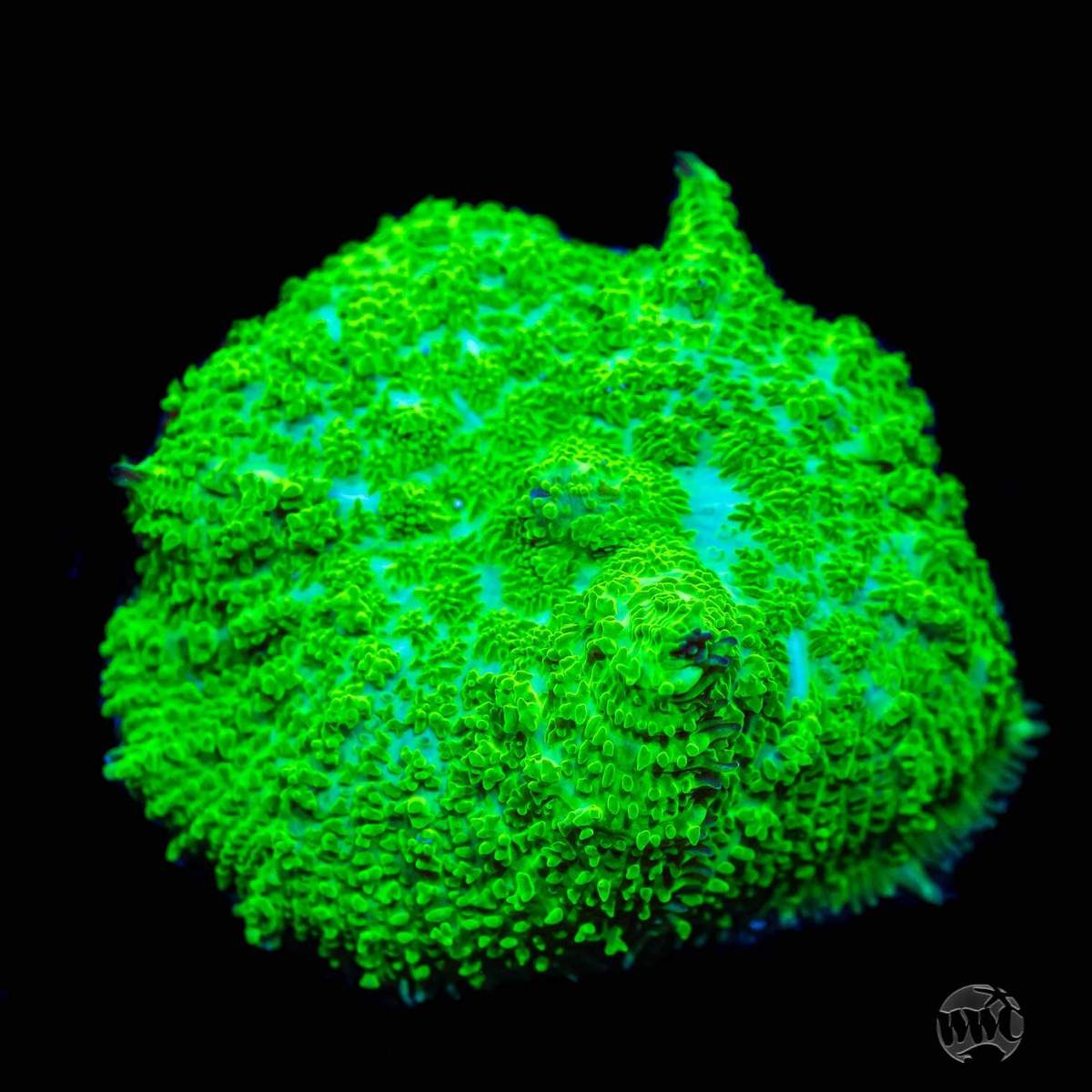If you are interested in finding more details about the different soft coral types and their care, this comprehensive guide is for you.
You’ll find all the information you need to know before trying to add these beautiful and resilient corals to your reef tank.
What are soft corals?
Soft coral is a term used to include a wide range of animals that have one thing in common: the lack of a hard, stony skeleton. On the opposite side, LPS and SPS corals are hard corals with a skeleton made of calcium carbonate.
That doesn’t mean soft corals are devoid of a skeleton. They have tiny pieces of skeleton, called sclerites, within their soft, big, and fleshy polyps. Sclerites are what help soft corals control their shape.
One thing they have in common with their “hard” cousins is the symbiotic relationship with zooxanthellae, the algae that live inside the coral and provide sugars created via photosynthesis. However, the degree to which soft corals depend on zooxanthellae to get food depends on the species.
Some species, such as Pulsing Xenia Corals and Leather Corals, depend on the algae living inside it entirely. These corals don’t eat solid food and therefore require intense lighting and a constant water flow of dissolved organic matter to live.
But other species, such as Mushroom Corals, survive mostly by extracting nutrients from the water and eating other organisms. That’s why this type of soft coral will thrive in low-light aquariums where photosynthesis is not that possible.
Soft Coral Types
As we mentioned, soft coral is a term that includes many types of animals. Let’s break down some of the most common soft coral types known in the hobby:
What are the best soft corals for beginners?
For the most part, all soft corals are excellent for beginners. These corals are the most forgiving to reefing mistakes such as placement, lighting, and nutrients.
Names of corals can be confusing to beginners so to help you out we’ve grouped some of the scientific names into common names used by hobbyists.
- Polyps (Pachyclavularia, Clavularia, Xenia, Anthelia)
- Mushroom Corals (Discosoma, Ricordea, Rhodactis)
- Leather Corals (Capnella, Sinularia, Sarcophyton, Lobophytum, Cladiella, Alcyonium)
- Palys (Palythoas)
- Zoas (Zoanthids)
Soft coral care
Soft corals are easier to keep than their cousins with hardy skeletons, and that’s why they are considered beginner corals.
They grow well in moderate to low lighting environments and even prefer dirtier water to have what to eat. Soft corals are more resistant to chemistry swings in the water, and a moderate to low water flow is enough for keeping them healthy. The moderate circulation is enough to move the food around the tank, however, a stronger flow can prevent the corals from opening.
Water parameters
These are the recommended water parameters for soft corals.
- Temperature: 72º – 76º Fahrenheit (~ 22 – 24º Celsius)
- Salinity: 30-35 ppt or Specific Gravity 1.023 – 1.026 sg
- Nitrate: < 20 ppm – Can be toxic to livestock if too high
- pH: between 7.8 and 8.2
- Phosphate: < .10 ppm
- Calcium: 420-440 ppm
- Alkalinity: between 8 and 9.5 dKH
- Magnesium: 1260-1350 ppm
Acclimation
Before adding soft corals to your tank, you should acclimate them from the bag of water.
This process is required to reduce the shock to the corals when changing environments. Advanced aquarists recommend the use of quarantine tanks for corals to make sure you don’t introduce pests into your display tank.
With acclimation, you give the corals the time to adapt to the new water parameters. While soft corals are more resistant to chemistry changes, you shouldn’t stress them more than it needs to. The biggest problems are changes in pH, salinity, and water temperature.
You can do the acclimation in the bucket or bag they came in. Add half a cup of water every 30 minutes from your main tank into the recipient until the water doubles in size. Then gently remove the corals, let them drip all the excess water (this is important), and place them in the tank.
Don’t let the bag/bucket water enter your tank, it can cause death to your system.
You can also dip your corals before adding them to your tank if you want to remove any possible pests they might carry. This is done before acclimation.
Growth rate
The growth rate of soft corals is dependent on water parameters and food availability. While you might think that the lack of a skeleton similar to LPS and SPS has made them grow faster, the same lack of skeleton also hinders the softies’ ability to grow.
In the best conditions, a soft coral colony can grow between 2-4 cm per year.
Placement/Spacing
The distance between soft corals depends on what type of soft coral you are introducing to the tank. 5-8 cm between them is a good start, however, keep in mind that some softies spread very fast and need to be kept in isolation.
Flow requirements
Soft corals don’t need a lot of water movement, so it’s recommended a water flow rate in the range of 20-40 gallons per hour (GPH). This number represents the number of times the water volume in the tank is moved during an hour. For example, a 200-gallon tank that has a GPH of 10,000 has a flow rate of 50x.
Lighting requirements
PAR
Some soft corals do well in low-moderate lighting while others prefer bright spots.
The best recommendation is 50-150 PAR all over the tank.
Light distribution is more important than having a higher value. Use a PAR meter to make sure there are no hot spots that can burn your corals.
Light acclimation
Light acclimation is the process of helping your corals adapt to the light in your system. That is done by starting at 50% light intensity and increasing it by 5% every 3 days until you reach full power.
Or it can be done using the light acclimation mode found on modern lighting systems.
However, soft corals don’t need high PAR anyway, therefore it is not necessary to do light acclimation.
If you want to be careful about it, simply place the soft coral in a darker spot and then move it after 1-2 weeks where you want to keep it permanently.
Feeding
As we mentioned, some soft corals depend entirely on the zooxanthellae to get food while other species survive by extracting nutrients from the water or by eating other organisms.
Most soft corals get their nutritional needs from floating plankton, detritus, phytoplankton, slow-moving invertebrate larvae, and dissolved organic material.
How often do you feed soft corals?
If you want to feed the soft corals directly, there is special food available at reef shops. Make sure to select food that has the smallest particles. Depending on the manufacturer, you can feed them 1-2 times a week or even more often.
Best time to feed soft corals
The best time to feed your softies is when the lights are out. This will ensure optimal nutrient absorption.
Switch off the skimmer during feed for at least one hour.
Soft coral pests
Pests can really affect your soft corals and even kill them if they have a chance. That’s why it’s important to know the most common pests and how to identify them.
#1 Aiptasia Anemone
Anemones can multiply quickly and dominate a reef aquarium. They pose a threat to the tank because they sting fish and corals. Agitating Aiptasia can release eggs into the water column, spreading the infection. There are many treatments available that you can use to cover or inject this pest. There is also the option of using natural predators such as Copperband Butterfly Fish, Peppermint Shrimp or Berghia Nudibranch.
#2 Coral Eating Nudibranchs
They are the most difficult to see critters in your aquarium. They are very small and take the color of the coral they are eating. Reproduction is quick and they can decimate soft corals.
Treatment is more tricky since eggs are resistant to coral dips, which are effective on adults. But you should still dip new corals as a precaution.
Physically removing Coral Eating Nudibranchs might be the best option. If you dip infected corals frequently you can starve persistent infestations.
#3 Bristle Worms
Bristle Worms are not a threat until the population is out of control or if they grow larger than 5”. Smaller worms can be helpful by consuming detritus, but larger specimens can attack coral, fish, and invertebrates.
The most effective way of getting rid of them is removing them. There are special Bristle Worm traps you can set, or sometimes you can grab them with a pair of tongs. Arrow Crabs, Dottyback, Wrasse, and Hawkfish are known to prey on them.
Soft coral bleaching
Coral bleaching happens when the tissue of the coral loses color or becomes translucent or white. The tissue itself remains attached to the corals, therefore it can be reversed.
Stress from the environment is the main cause of soft coral bleaching.
Keep your tank parameters stable and within range to prevent bleaching.
Why are my soft corals dying?
This is commonly called tissue necrosis, and it can be of two types based on speed. Rapid Tissue Necrosis (RTN) happens in 24 hours and Slow Tissue Necrosis (STN) can take days or even months.
Some of the most common reasons for tissue necrosis in soft corals are:
- Sudden change in alkalinity
- A drastic change in salinity
- Consistently low alkalinity levels
- Temperature swings, up or down
- Bacteria such as Philaster Guamense and Philaster Lucinda
STN is difficult to stop and RTN is almost impossible to stop. To minimize the damage make sure that temperature, alkalinity, salinity, and pH are within an optimal range. Test daily until resolution.
Cut off the impacted areas of the soft coral. To stop the spread of tissue necrosis, cut into the healthy flesh of the coral below and above the affected area.
Why are my soft corals turning brown?
Soft corals turn brown as a result of the overproduction of zooxanthellae. As the bacteria levels increase, they block the corals’ natural pigment, turning them brown.
This is typically caused by:
- High level of nitrates and phosphates. They are a food source for zooxanthellae, resulting in overproduction
- A constant fluctuation in tank parameters
- More intense lighting for new corals than their previous environment
Keep your tank parameters stable and slowly move your new corals to increase the light intensity until they are happy.
Soft Coral Spawning
Most corals are hermaphrodites, as they produce both female and male reproductive cells.
Spawning involves eggs and sperm being released into the water at the same time. In nature, this happens at the same time, once a year, depending on the moon phase. All corals in the colony release their eggs and sperm at the same time in a great spectacle.
However, spawning soft corals in a home aquarium is a very rare sight. It rarely happens.
Are soft corals hard to keep?
Soft corals are the easiest corals to keep in a reef tank, that’s why they are recommended for beginners. They are incredibly hardy, they reproduce quickly and they can thrive even in low lighting.
What is the easiest soft coral to keep?
Cladiella corals are the easiest soft coral to keep. They thrive in moderate lighting and water movement, and they are not sensitive to handling as other types of soft corals. They grow and reproduce well, being able to overgrow other corals in the aquarium.
Are soft corals aggressive?
Soft corals are usually aggressive and engage in chemical warfare with other corals, releasing a toxic cloud around them. Some species dominate other corals by overgrowing them.
It’s usually best to study the aggressiveness of your specific soft corals, but they usually require space and solitude.
Are soft corals filter feeders?
Yes. Soft corals are mostly photosynthetic, depending on zooxanthellae to convert light into food through photosynthesis. But unlike algae and plants, soft corals can also capture and eat tiny prey with their small polyps. That makes them a filter feeder.
Can soft coral move?
Yes, soft corals are able to move slowly by extending their base, clearing the path with the help of toxins.
Are anemones soft corals?
No, they are not a type of soft coral.
Anemones are cnidarians like jellyfish, corals, and hydroids. While they might resemble the appearance of soft corals, anemones are a single organism while soft corals live in colonies.
